- Looking for a student learning guide? It’s in the main menu for your course. Use the “Courses” menu above.
- Click here for an overview video.
1. Introduction: Cellular respiration is how cells take the energy in food and make it into ATP, the cell’s moment-to-moment energy source
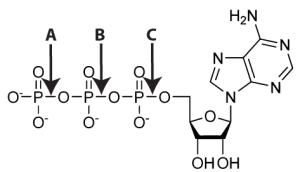 Think about how important eating is. As I pointed out in the previous tutorial (about ATP), there are two reasons why we eat. The first is to replenish our store of the molecules that make us up, which we need in order to grow and repair ourselves. The second is to take the chemical bond energy in the molecules in the food we eat and use it to attach a phosphate group onto ADP (adenosine diphosphate), creating ATP (adenosine triphosphate). Creating ATP from ADP and phosphate is endergonic: it requires energy to drive the process forward, and that energy comes from food. Once the cell has ATP, it can use the bond energy in the bond between the second and third phosphate groups in ATP (bond “A” in the diagram to the left) to power all of life’s endergonic reactions.
Think about how important eating is. As I pointed out in the previous tutorial (about ATP), there are two reasons why we eat. The first is to replenish our store of the molecules that make us up, which we need in order to grow and repair ourselves. The second is to take the chemical bond energy in the molecules in the food we eat and use it to attach a phosphate group onto ADP (adenosine diphosphate), creating ATP (adenosine triphosphate). Creating ATP from ADP and phosphate is endergonic: it requires energy to drive the process forward, and that energy comes from food. Once the cell has ATP, it can use the bond energy in the bond between the second and third phosphate groups in ATP (bond “A” in the diagram to the left) to power all of life’s endergonic reactions.
The overall chemical equation for cellular respiration is:
C6H12O6 + 6O2 –> 6CO2 + 6H2O + energy (in the form of ATP)
In plain English, glucose (C6H12O6) is combined with oxygen (O2) in order to create ATP. Carbon dioxide (CO2) and water (H2O) are released as waste products.
Cells carry out this transfer of energy from food to ATP very efficiently. During cellular respiration, cells can transform the energy in one molecule of glucose into somewhere between 30 and 32 molecules of ATP (I’ll explain why there’s a range in another tutorial). This transfer of energy is about 39% efficient (according to Reference.com). That’s a lot more efficient than a car, which converts between 14 and 30% of the fuel energy you put into a car into movement(source: US Dept. of Energy). Cells, of course, have been working on this for billions of years, so human engineers (who’ve been at it for a much shorter period of time) shouldn’t feel bad.
Creating ATP is a cellular process, so let’s look at the cell parts that are involved.
2. Where cellular respiration happens: the cellular context
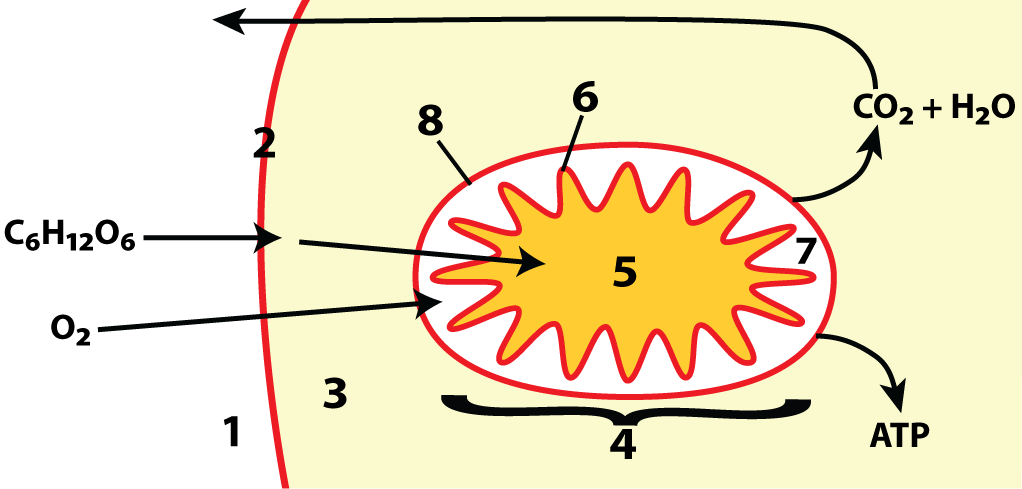
In the diagram on the left, “1” represents the cell exterior. In the cells of any non-photosynthetic eukaryote (such as a person, bread mold, or a paramecium), glucose and oxygen are going to come from outside the cell. Because cellular respiration consumes glucose and oxygen, there’s always a concentration gradient allowing glucose and oxygen to diffuse through the cell’s membrane (shown at “2”) into the cytoplasm (at “3”). As we’ve learned in our studies of membrane transport, the cell has special protein channels for glucose, a polar molecule, while oxygen can diffuse directly through the membrane’s phospholipid bilayer.
In eukaryotic cells, the organelle that does the lion’s share of the work of cellular respiration is the mitochondrion (shown at “4”). I’ve included only one mitochondrion in this drawing, but the cells in your body can have thousands (note, by the way, that mitochondrion is the singular form of mitochondria, which is plural). Mitochondria evolved from a once-independent bacterial ancestor that, about two billion years ago, took up residence inside another prokaryotic cell, creating the eukaryotic lineage that we animals (along with the fungi, protists, and plants) are a part of. If you’re interested in the origins of mitochondria, you can read more about it in this article in Nature, or in this article from the National Center for Biotechnology Information. Both of them will be challenging. Go for it!
Mitochondria have a double membrane. The inner one is shown at “6,” and the outer one at “8.” In between the two is the intermembrane space, shown at “7.”
Oxygen will diffuse from the cell’s exterior, into the cytoplasm, and then into the mitochondria. Glucose, by contrast, will be partially broken down for energy in the cytoplasm, and then continue into the central fluid of the mitochondria, known as the matrix (shown at “5”).
3. Substrate level phosphorylation creates a small amount of ATP
As we’ll see in this tutorial and ones that follow, there are only two ways that cells make ATP during cellular respiration.
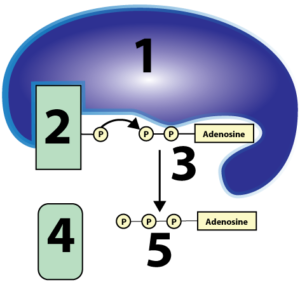 The first is called substrate-level phosphorylation. This term tells you exactly what it’s about. In the diagram at left, you can see an enzyme (1) transfer a phosphate from some organic substrate (2) to ADP (3), creating ATP (5). “Substrate-level” means that the process is catalyzed by an enzyme, working on a substrate that’s losing its phosphate group, and passing that phosphate to a second substrate, ADP. “Phosphorylation” means that ADP is gaining a phosphate, becoming ATP. And, just in case you were worried about what “4” is, it’s one of the two products of this reaction (the other one being ATP).
The first is called substrate-level phosphorylation. This term tells you exactly what it’s about. In the diagram at left, you can see an enzyme (1) transfer a phosphate from some organic substrate (2) to ADP (3), creating ATP (5). “Substrate-level” means that the process is catalyzed by an enzyme, working on a substrate that’s losing its phosphate group, and passing that phosphate to a second substrate, ADP. “Phosphorylation” means that ADP is gaining a phosphate, becoming ATP. And, just in case you were worried about what “4” is, it’s one of the two products of this reaction (the other one being ATP).
During cellular respiration, substrate-level phosphorylations occur in the cell’s cytoplasm, and in the mitochondrial matrix, generating a small amount of ATP. But we’ll see that the majority of the ATP is made through a less direct process called oxidative phosphorylation. Oxidative phosphorylation belongs to a class of chemical reactions called oxidation/reduction reactions, so let’s see how these reactions work.
Note that ATP production is also a part of photosynthesis (but we’ll leave that for the next AP Bio Topic).
[qwiz random = “true” qrecord_id=”sciencemusicvideosMeister1961-Cellular Respiration Overview (M10)”]
[h]Cellular Respiration Overview Quiz 1
[i]
[q]Which number is the cell membrane?
[textentry single_char=”true”]
[c]wq Ay[Qq]
[f]IFllcywg4oCcMuKAnSBpcyB0aGXCoGNlbGwgbWVtYnJhbmU=[Qq]
[c]Kg==[Qq]
[f]Tm8uwqBUaGUgbWVtYnJhbmUgaXMgdGhlIGNlbGwmIzgyMTc7cyBvdXRlciBib3VuZGFyeS4gSWYgdGhlIGdsdWNvc2UgYW5kIG94eWdlbiAoQw==Ng==SA==MTI=Tw==[Qq]6 6O2) are outside the cell, and the cytoplasm is at “3,” then what number would be representing the membrane?
[q]Which number is the cytoplasm?
[textentry single_char=”true”]
[c]wq Az[Qq]
[f]IFllcywg4oCcM+KAnSBpcyB0aGXCoGN5dG9wbGFzbS4=[Qq]
[c]Kg==[Qq]
[f]Tm8uwqBUaGUgY3l0b3BsYXNtIGlzIHRoZSBmbHVpZCByZWdpb24gYmV0d2VlbiB0aGUgY2VsbCYjODIxNztzIG1lbWJyYW5lIGFuZCB0aGUgbnVjbGV1cyAod2hpY2ggaXNuJiM4MjE3O3Qgc2hvd24gaW4gdGhpcyBkaWFncmFtKS4gV2hpY2ggbnVtYmVyIGlzIGp1c3QgaW5zaWRlIHRoZSBtZW1icmFuZSAoYnV0IG5vdCBwYXJ0IG9mIGFueSBvdGhlciBzdHJ1Y3R1cmUpPw==
Cg==[Qq]
[q]Which number is the mitochondrion?
[textentry single_char=”true”]
[c]wq A0[Qq]
[f]IFllcywg4oCcNOKAnSBpcyB0aGUgbWl0b2Nob25kcmlvbi4=[Qq]
[c]Kg==[Qq]
[f]Tm8uIExvb2sgZm9yIHRoZcKgY2VsbC1saWtlIG9yZ2FuZWxsZSBpbnNpZGUgdGhlIGN5dG9wbGFzbS4=
Cg==[Qq]
[q]Which number is the mitochondrial matrix?
[textentry single_char=”true”]
[c]ID U=[Qq]
[f]IFllcywg4oCcNeKAnSBpcyB0aGUgbWF0cml4Lg==[Qq]
[c]Kg==[Qq]
[f]Tm8uwqBUaGXCoG1hdHJpeCBpcyBhbmFsb2dvdXMgdG8gdGhlIGN5dG9wbGFzbSBvZiBhwqBtaXRvY2hvbmRyaW9uLiBJZiB0aGF0JiM4MjE3O3Mgbm90IGVub3VnaCBvZiBhIGhpbnQsIGl0JiM4MjE3O3MgdGhlIHJlZ2lvbiBpbnNpZGUgb2YgYcKgbWl0b2Nob25kcmlvbiYjODIxNztzIGlubmVyIG1lbWJyYW5lLg==
Cg==[Qq]
[q]Which number is the mitochondrial inner membrane?
[textentry single_char=”true”]
[c]wq A2[Qq]
[f]IFllcywg4oCcNuKAnSBpcyB0aGUgbWl0b2Nob25kcmlhbCBpbm5lciBtZW1icmFuZS4=[Qq]
[c]Kg==[Qq]
[f]Tm8uIFN0YXJ0IGJ5IGZpbmRpbmcgYSBtaXRvY2hvbmRyaW9uICh0aGUgb25seSBzdHJ1Y3R1cmUgc2hvd24sIGluIHRoaXMgZGlhZ3JhbSwgaW5zaWRlIHRoZSBjZWxsKS4gTm90ZSB0aGF0IGl0IGhhcyB0d28gbWVtYnJhbmVzLiBUaGUgaW5uZXIgb25lIGlzIGhpZ2hseSBmb2xkZWQu
Cg==[Qq]
[q]Which number is the intermembrane space?
[textentry single_char=”true”]
[c]wq A3[Qq]
[f]IFllcywg4oCcN+KAnSBpcyB0aGXCoGludGVybWVtYnJhbmUgc3BhY2Uu[Qq]
[c]Kg==[Qq]
[f]Tm8uwqBUaGUgaW50ZXJtZW1icmFuZSBzcGFjZSBpcyB0aGUgcmVnaW9uIG9mIGEgbWl0b2Nob25kcmlvbiBpbi1iZXR3ZWVuIHRoZSBpbm5lciBhbmQgb3V0ZXIgbWVtYnJhbmUuIElmIHRoZSBtaXRvY2hvbmRyaW9uIGl0c2VsZiBpcyBhdCAmIzgyMjA7NCwmIzgyMjE7IHRoZW4gd2hhdCBudW1iZXIgd291bGQgYmUgdGhlIGludGVybWVtYnJhbmUgc3BhY2U/
Cg==[Qq]
[q]Which number is the mitochondrial outer membrane?
[textentry single_char=”true”]
[c]wq A4[Qq]
[f]IFllcywg4oCcOOKAnSBpcyB0aGUgbWl0b2Nob25kcmlhbCBvdXRlciBtZW1icmFuZS4=[Qq]
[c]Kg==[Qq]
[f]Tm8uwqBUaGUgb3V0ZXIgbWl0b2Nob25kcmlhbCBtZW1icmFuZSBpc8KgdGhlIHNlbGVjdGl2ZWx5IHBlcm1lYWJsZSBiYXJyaWVyIHRoYXQgc2VwYXJhdGVzIHRoZSBtaXRvY2hvbmRyaW9uICgmIzgyMjA7NCYjODIyMTspIGZyb20gdGhlIGN5dG9wbGFzbSAoJiM4MjIwOzMmIzgyMjE7KS4gS2VlcGluZyBpbiBtaW5kIHRoZSBmYWN0IHRoYXQgbWl0b2Nob25kcmlhIGhhdmUgYSBkb3VibGUgbWVtYnJhbmUsIHdoaWNoIG51bWJlciBoYXMgdG8gYmUgdGhlIG91dGVyIG9uZT8=
Cg==[Qq]
[q]Which number is the outside of the cell?
[textentry single_char=”true”]
[c]wq Ax[Qq]
[f]IFllcywg4oCcMeKAnSBpcyB0aGUgb3V0c2lkZSBvZiB0aGUgY2VsbC4=[Qq]
[c]Kg==[Qq]
[f]Tm8uwqBUaGUgb3V0c2lkZSBvZiB0aGUgY2VsbCwgb3IgY2VsbCBleHRlcmlvciwgaXMgdGhlIHJlZ2lvbiBvdXRzaWRlIG9mIHRoZSBjZWxsJiM4MjE3O3MgbWVtYnJhbmUuIFdoYXQmIzgyMTc7cyBleHRlcmlvciB0byB0aGUgbWVtYnJhbmU/
Cg==[Qq]
[q]Which numbered part of the image is the enzyme?
[textentry single_char=”true”]
[c]ID E=[Qq]
[f]IFllcywg4oCcMeKAnSBpcyB0aGUgZW56eW1lLg==[Qq]
[c]Kg==[Qq]
[f]Tm8uIEhlcmUmIzgyMTc7cyBhIGhpbnQuIEVuenltZXMgYXJlIGxhcmdlIHByb3RlaW5zLCB1c3VhbGx5IG11Y2ggbGFyZ2VyIHRoYW4gdGhlaXIgc3Vic3RyYXRlcy4gV2hhdCYjODIxNztzIHRoZSBiaWdnZXN0IHRoaW5nIGluIHRoaXMgZGlhZ3JhbT8=
Cg==[Qq]
[q]Which numbered part of the image is the source of the phosphate that will convert ADP to ATP?
[textentry single_char=”true”]
[c]wq Ay[Qq]
[f]IFllcywg4oCcMuKAnSBpc8KgdGhlIG1vbGVjdWxlIHRoYXQgcHJvdmlkZXMgdGhlIHBob3NwaGF0ZSB1c2VkIHRvIHBob3NwaG9yeWxhdGUgQURQIHRvIEFUUC4=[Qq]
[c]Kg==[Qq]
[f]Tm8uIEhlcmUmIzgyMTc7cyBhIGhpbnQuwqBMb29rIGZvciBhIHBob3NwaGF0ZSBjb250YWluaW5nIG1vbGVjdWxlIHRoYXQmIzgyMTc7cyA=bm90IEFEUCBvciBBRFAu
Cg==[Qq]
[q]Which numbered part of the image is ADP?
[textentry single_char=”true”]
[c]wq Az[Qq]
[f]IFllcywg4oCcM+KAnSBpcyBBRFAu[Qq]
[c]Kg==[Qq]
[f]Tm8uIEhlcmUmIzgyMTc7cyBhIGhpbnQuwqBBRFAgc3RhbmRzIGZvciBhZGVub3NpbmUgZGlwaG9zcGhhdGUuICYjODIyMDtEaSYjODIyMTsgbWVhbnMgJiM4MjIwO3R3by4mIzgyMjE7IEZpbmQgYSBtb2xlY3VsZSB3aXRoIHR3byBwaG9zcGhhdGUgZ3JvdXBzIChyZXByZXNlbnRlZCBieSAmIzgyMjA7cCYjODIyMTsgd2l0aGluIGEgY2lyY2xlKS4=
Cg==[Qq]
[q]Which numbered part of the image is ATP?
[textentry single_char=”true”]
[c]wq A1[Qq]
[f]IFllcywg4oCcNeKAnSBpcyBBVFAu[Qq]
[c]Kg==[Qq]
[f]Tm8uIEhlcmUmIzgyMTc7cyBhIGhpbnQuwqBBVFAgc3RhbmRzIGZvciBhZGVub3NpbmUgdHJpcGhvc3BoYXRlLiAmIzgyMjA7VHJpJiM4MjIxOyBtZWFucyAmIzgyMjA7dGhyZWUuJiM4MjIxOyBGaW5kIGEgbW9sZWN1bGUgd2l0aCB0aHJlZcKgcGhvc3BoYXRlIGdyb3VwcyAocmVwcmVzZW50ZWQgYnkgJiM4MjIwO3AmIzgyMjE7IHdpdGhpbiBhIGNpcmNsZSku
Cg==[Qq]
[q]This substrate level phosphorylation has two products. ATP is one. Which number indicates the other one?
[textentry single_char=”true”]
[c]wq A0[Qq]
[f]IFllcywg4oCcNOKAnSBpc8KgdGhlIGRlcGhvc3Bob3J5bGF0ZWQgcHJvZHVjdCBvZiB0aGUgcmVhY3Rpb25zLg==[Qq]
[c]Kg==[Qq]
[f]Tm8uIEhlcmUmIzgyMTc7cyBhIGhpbnQuIEFUUCBpcyBvbmUgb2YgdGhlIHByb2R1Y3RzIG9mIHRoaXMgcmVhY3Rpb24uIFRoZSBvdGhlciBwcm9kdWN0IGRvbmF0ZWQgdGhlIHBob3NwaGF0ZSB0aGF0IGlzIG5vdyBwYXJ0IG9mIEFUUC4gV2hpY2ggbnVtYmVyIHBvaW50cyB0byBhIG1vbGVjdWxlIHRoYXQgbG9zdCBpdHMgcGhvc3BoYXRlIGR1cmluZyB0aGlzIHN1YnN0cmF0ZS1sZXZlbCBwaG9zcGhvcnlsYXRpb24/
Cg==[Qq]
[q]In this substrate level phosphorylation, there are two substrates. Which number represents the substrate that is not ADP?
[textentry single_char=”true”]
[c]wq Ay[Qq]
[f]IFllcywg4oCcMuKAnSBpc8KgdGhlIHN1YnN0cmF0ZSB0aGF0IGlzIA==bm90IEFEUDogdGhlIG1vbGVjdWxlIHRoYXQgcHJvdmlkZXMgdGhlIHBob3NwaGF0ZSB1c2VkIHRvIHBob3NwaG9yeWxhdGUgQURQIHRvIEFUUC4=[Qq]
[c]Kg==[Qq]
[f]Tm8uIEhlcmUmIzgyMTc7cyBhIGhpbnQuIExvb2sgZm9yIGEgcGhvc3BoYXRlLWNvbnRhaW5pbmcgbW9sZWN1bGUgbmVzdGxlZCBpbnRvIHBhcnQgb2YgdGhpcyBlbnp5bWUmIzgyMTc7cyBhY3RpdmUgc2l0ZSwgYnV0IHdoaWNoIGlzIA==bm90IEFEUC4=[Qq]
[x][restart]
[/qwiz]
4. Oxidation and reduction reactions are how most ATP is made during cellular respiration
 As you read above, substrate-level phosphorylations account for only a small amount of the ATP generated during cellular respiration (about an eighth of the ATP produced). Much more ATP is produced by oxidizing glucose and using the energy harvested from that oxidation to set up the conditions to generate ATP from ADP and phosphate. So what is oxidation?
As you read above, substrate-level phosphorylations account for only a small amount of the ATP generated during cellular respiration (about an eighth of the ATP produced). Much more ATP is produced by oxidizing glucose and using the energy harvested from that oxidation to set up the conditions to generate ATP from ADP and phosphate. So what is oxidation?
Oxidation means the loss of electrons. Oxidation is paired with a complementary process called reduction, which means the gain of electrons. Oxidation-reduction reactions happen all the time. Every time you drive your car, light a match or operate a gas stove, you’re involved with an oxidation-reduction reaction.
In all of the processes listed above, an energy-rich fuel (gasoline, wood, or natural gas, respectively) gets oxidized, losing its energy-rich electrons and hydrogen atoms. At the same time, oxygen gets reduced, gaining electrons and hydrogen atoms.
Here’s the equation for what happens when methane, CH4 (commonly called “natural gas”) is burned:
CH4 + 2O2 –> CO2 + 2H2O + energy (in the form of heat and light)
Methane, an energy rich fuel, is oxidized. The result is energy (heat and light), along with carbon dioxide and water (two exhaust products)
From a biology student’s perspective, it’s useful to roughly equate oxidation with the release of energy (powering work), and reduction with storing energy. In other words, when a fuel like methane is oxidized, it releases energy. Oxidized substances (like carbon dioxide) don’t have free energy for accomplishing cellular work. That’s why carbon dioxide is an exhaust product. Think of this oxidized compound as being exhausted: unable to do work. By contrast, substances that are reduced (like methane) have available free energy that can be harvested in order to do work.
What are some other examples of reduced substances?
- gasoline
- peanut butter
- alcohol
- spaghetti
- meat
- sugar
- wood
Note that foods are all reduced substances. They’re full of high-energy electrons that we can use to power the work that we organisms need to stay alive, grow, and reproduce. When cells need energy, they take a reduced fuel (which means foods like glucose) and oxidize it. The result, just like in the combustion of methane shown above, is the release of energy, and the production of the waste products carbon dioxide and water. Here, once again, is the overall chemical equation for the oxidation of glucose that happens in your cells.
C6H12O6 + 6O2 → 6CO2 + 6H2O + energy (in the form of ATP)
But while the chemical equations for the oxidation of methane during combustion and the oxidation of glucose during cellular respiration are similar, the details couldn’t be more different. But before going into these details, let’s make sure you’ve mastered the overall equation for cellular respiration.
[qdeck random = “true” qrecord_id=”sciencemusicvideosMeister1961-Cellular Respiration Equation Flashcards (M10)”]
[h]Flashcards: The equation for cellular respiration
[i]C6H12O6 + 6O2 –>
6CO2 + 6H2O + energy (in the form of ATP)
[!!!!!] Card 1 [/!!!!!]
[q]Complete this word equation for cellular respiration
________ + oxygen –> ATP + carbon dioxide + water
[textentry]
[a]glucose + oxygen –> ATP + carbon dioxide + water
[!!!!!] Card 2 [/!!!!!]
[q]Complete this word equation for cellular respiration
glucose+ _________ –>ATP + carbon dioxide + water
[textentry]
[a]glucose+ oxygen –>ATP + carbon dioxide + water
[!!!!!] Card 3 [/!!!!!]
[q]Complete this word equation for cellular respiration
glucose+ oxygen –> ______ + carbon dioxide + water
[textentry]
[a]glucose+ oxygen –> ATP + carbon dioxide + water
[!!!!!] Card 4 [/!!!!!]
[q]Complete this word equation for cellular respiration
glucose+ oxygen –> ATP + ______ ________ + water
[textentry]
[a]glucose+ oxygen –> ATP+ carbon dioxide + water
[!!!!!] Card 5 [/!!!!!]
[q]Complete this word equation for cellular respiration
glucose+ oxygen –> ATP+ carbon dioxide+ __________
[textentry]
[a]glucose+ oxygen –> ATP+ carbon dioxide+ water
[!!!!!] Card 6 [/!!!!!]
[q]Complete this word equation for cellular respiration
________+ ________–> ATP + carbon dioxide+ water
[textentry]
[a] glucose+ oxygen –> ATP+ carbon dioxide+ water (glucose and oxygen in either order)
[!!!!!] Card 7 [/!!!!!]
[q]Complete this word equation for cellular respiration
glucose+ oxygen –> ____ + ______+ _______
[textentry]
[a] glucose+ oxygen –> ATP+ carbon dioxide+ water (these three in any order)
[!!!!!] Card 8 [/!!!!]
[q]Complete this chemical equation for cellular respiration
_______ + 6O2 –> energy(ATP) + 6CO2 + 6H2O (don’t worry about typing subscripts)
[textentry]
[a] C6H12O6 + 6O2 –> energy(ATP) + 6CO2 + 6H2O
[!!!!!] Card 9 [/!!!!]
[q]Complete this chemical equation for cellular respiration
C6H12O6 + ______ –> energy(ATP) + 6CO2 + 6H2O (don’t worry about typing subscripts)
[textentry]
[a] C6H12O6 + 6O2 –> energy(ATP) + 6CO2 + 6H2O
[!!!!!] Card 10 [/!!!!]
[q]Complete this chemical equation for cellular respiration
C6H12O6 + 6O2 –> _______ + 6CO2 + 6H2O
[textentry]
[a] C6H12O6 + 6O2 –> energy (ATP) + 6CO2 + 6H2O
[!!!!!] Card 11 [/!!!!]
[q]Complete this chemical equation for cellular respiration
C6H12O6 + 6O2 –> energy(ATP) + _____ + 6H2O (don’t worry about typing subscripts)
[textentry]
[a] C6H12O6 + 6O2 –> energy(ATP) + 6CO2 + 6H2O
[!!!!!] Card 12 [/!!!!]
[q]Complete this chemical equation for cellular respiration
C6H12O6 + 6O2 –> energy(ATP) + 6CO2 + _____ (don’t worry about typing subscripts)
[textentry]
[a]C6H12O6 + 6O2 –> energy(ATP) + 6CO2 + 6H2O
[!!!!!] Card 13 [/!!!!!]
[q]The goal of cellular respiration is the production of ______.
[textentry]
[a]The goal of cellular respiration is the production of ATP.
[!!!!!] Card 14 [/!!!!!]
[q]An important molecule used as a fuel in cellular respiration is ______.
[textentry]
[a]An important molecule used as a fuel in cellular respiration is glucose.
[!!!!!] Card 15 [/!!!!!]
[q]One of the waste products of cellular respiration is a gas that contains a carbon atom. This gas is ______ _______.
[textentry]
[a]One of the waste products of cellular respiration is a gas that contains a carbon atom. This gas is carbon dioxide.
[!!!!!] Card 16 [/!!!!!]
[q]One of the waste products of cellular respiration contains the element hydrogen. This substance is ______.
[textentry]
[a]One of the waste products of cellular respiration contains a hydrogen atom. This substance is water.
[x]
[restart]
[/qdeck]
5. The oxidations and reductions in cellular respiration involve electron carriers
When glucose (or other foods) get oxidized to create ATP, the oxidation happens in many small steps. During these steps, glucose and the intermediate products that it gets broken down into as it slowly gets transformed into carbon dioxide and water get oxidized. As this oxidation occurs, electrons and hydrogen atoms get transferred to two mobile electron carriers: NAD+, and FAD. When NAD+ and FAD accept these electrons, they become reduced. NAD+ becomes NADH. FAD becomes FADH2.
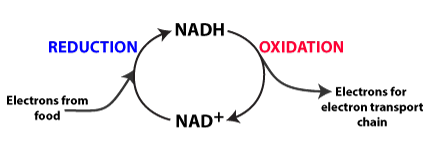 |
 |
It’s useful to think of NADH and FADH2 as charged-up, rechargeable batteries. When you place a charged battery into a device like a radio, the battery can create an electrical current. An electrical current is a flow of electrons that can be used to do some work (like taking a radio signal, amplifying it, and converting it into sound). NADH and FADH2 do a similar thing. They carry electron energy from either the cytoplasm or the mitochondrial matrix and bring it to the inner mitochondrial membrane. Once there, they release their electrons to a series of membrane-embedded electron carriers called the electron transport chain. The electron transport chain uses this electron energy to create ATP.
Just think of it this way: If cellular respiration were a game of football and energetic electrons were the ball, then the end zone would be the inner membrane of the mitochondria, where the electron transport chain is found. NADH and FADH2 are like fullbacks: they carry the ball (the electrons) to the end zone.
We’ll learn the astounding details of how this ATP is generated in a later tutorial, but for now, study this diagram.
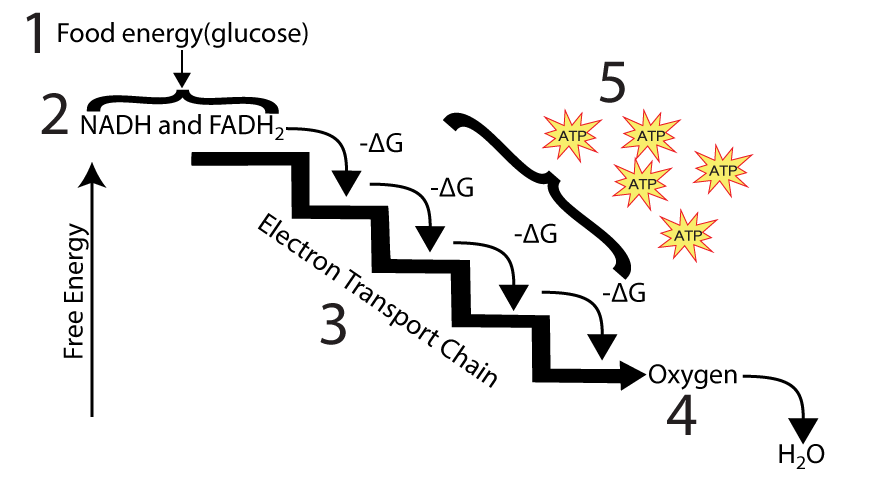
“1” represents the source of all the energy: food. A series of oxidations take the energy in glucose and transfer it to NADH and FADH2 (shown at “2”). NADH and FADH2 are mobile electron carriers: they bring these energetic electrons from the cell’s cytoplasm or the mitochondrial matrix to the electron transport chain, which is located along the inner membrane of the mitochondria. There, the proteins that make up the electron transport chain use the energy in these electrons to synthesize ATP. At the end of the process, these electrons flow to oxygen, which is the final acceptor in the chain.
6. Cellular respiration occurs in four phases
Let’s take stock of what we’ve covered so far
- The purpose of cellular respiration is to convert the potential chemical energy in food into the potential chemical energy in ATP, life’s moment-to-moment energy currency.
- During cellular respiration, a small amount of ATP is generated through substrate-level phosphorylations that occur in the cell’s cytoplasm and in the mitochondrial matrix.
- Much more ATP is generated through a several-step process involving:
- The step-by-step oxidation of glucose
- The reduction of the mobile electron carriers NAD+ and FAD to NADH and FADH2, respectively.
- The transport of energetic electrons by NADH and FADH2 to the electron transport chain in the inner membrane of the mitochondria, where most of the ATP generated during cellular respiration is synthesized.
This brings us almost to the end of this overview of cellular respiration. The last things to learn are the names of the four phases of cellular respiration. Don’t let the diagram below panic you. Soon, it will be as familiar as an old friend. Let’s look at each phase.

- Phase 1 is glycolysis. It produces ATP and NADH. Glucose is split apart and oxidized, resulting in a three carbon molecule that still has lots of potential energy. This molecule is called pyruvic acid, or pyruvate. Note that there are two molecules of pyruvate produced for every glucose that enters glycolysis.
- Pyruvate then diffuses into the mitochondrial matrix. There, in the link reaction, pyruvate is oxidized, producing more NADH. In this process, a carboxyl group (COO–) is removed, leaving a two-carbon molecule called acetyl Co-A.
- This two-carbon acetyl Co-A still has plenty of potential energy. In the Krebs cycle, this energy is harvested to generate ATP, NADH, and FADH2.
- In the electron transport chain, the cell harvests the electron energy it has stored away in the reduced mobile electron carriers NADH and FADH2. The majority of the ATP generated during cellular respiration is synthesized in this final step.
7. Cellular Respiration Overview: Checking Understanding
Before exploring each phase of cellular respiration in more detail, let’s consolidate our understanding with the following quiz.
[qwiz random = “true” qrecord_id=”sciencemusicvideosMeister1961-Cellular Respiration Quiz 2 (M10)”]
[h]Cellular Respiration Overview Quiz 2
[i]
[q]Which phase is glycolysis?
[textentry single_char=”true”]
[c]ID E=[Qq]
[f]IFllcywg4oCcMeKAnSBpcyBnbHljb2x5c2lz[Qq]
[c]Kg==[Qq]
[f]Tm8uIEhlcmUmIzgyMTc7cyBhIGhpbnQuIEdseWNvbHlzaXMgbWVhbnMgJiM4MjIwO3NwbGl0dGluZyBzdWdhci4mIzgyMjE7IExvb2sgZm9yIGEgc3VnYXIsIGFuZCBsb29rIGZvciBhIHByb2Nlc3MgdGhhdCBzcGxpdHMgaXQgYXBhcnQu
Cg==[Qq]
[q]Which phase is the link reaction?
[textentry single_char=”true”]
[c]wq Ay[Qq]
[f]IFllcywg4oCcMuKAnSBpc8KgdGhlIGxpbmsgcmVhY3Rpb24u[Qq]
[c]Kg==[Qq]
[f]Tm8uIEhlcmUmIzgyMTc7cyBhIGhpbnQuwqBUaGUgbGluayByZWFjdGlvbiBsaW5rcyBnbHljb2x5c2lzICh3aGljaCBtZWFucyAmIzgyMjA7c3BsaXR0aW5nIHN1Z2FyJiM4MjIxOykgd2l0aCB0aGUga3JlYnMgY3ljbGUuIFdoaWNoIG51bWJlciBpbmRpY2F0ZXMgYSBwcm9jZXNzIHRoYXQgbGlua3Mgc29tZXRoaW5nIHRoYXQgc3BsaXRzIHN1Z2FyIHdpdGggc29tZXRoaW5nIHRoYXQgbG9va3MgY3ljbGljYWw/
Cg==[Qq]
[q]Which phase of cellular respiration is the electron transport chain?
[textentry single_char=”true”]
[c]wq A0[Qq]
[f]IFllcy7CoFRoZSBkZXNjZW5kaW5nIHN0YWlyd2F5IG9uIHRoZSBmYXIgcmlnaHQgd2l0aCBwcm9kdWN0aW9uIG9mIDI2IG9yIDI4IEFUUHMgaXMgdGhlIGVsZWN0cm9uIHRyYW5zcG9ydCBjaGFpbi4=[Qq]
[c]Kg==[Qq]
[f]Tm8uIEhlcmUmIzgyMTc7cyBhIGhpbnQuIFRoZSBlbGVjdHJvbiB0cmFuc3BvcnQgY2hhaW4gaW52b2x2ZXMgYSBzZXJpZXMgb2YgZW56eW1lcyB0aGF0IGFjY2VwdCBhbmQgaGFuZCBvZmYgZW5lcmdldGljIGVsZWN0cm9ucyBmcm9tIE5BREggYW5kIEZBREg=MiwgY3JlYXRpbmcgY29uZGl0aW9ucyBmb3IgZ2VuZXJhdGluZyBtb3JlIEFUUCB0aGFuIGFueSBvdGhlciBwYXJ0IG9mIGNlbGx1bGFyIHJlc3BpcmF0aW9uLiBXaGljaCBwaGFzZSBvZiBjZWxsdWxhciByZXNwaXJhdGlvbiBnZW5lcmF0ZXMgdGhlIG1vc3QgQVRQPw==
Cg==[Qq]
[q]Which phase of cellular respiration occurs in the cytoplasm?
[textentry single_char=”true”]
[c]wq Ax[Qq]
[f]IFllcy7CoEdseWNvbHlzaXMgb2NjdXJzIGluIHRoZSBjeXRvcGxhc20u[Qq]
[c]Kg==[Qq]
[f]Tm8uIEhlcmUmIzgyMTc7cyBhIGhpbnQuIEl0IGludm9sdmVzIHNwbGl0dGluZyBnbHVjb3NlIGludG8gdHdvIG1vbGVjdWxlcyBvZiBweXJ1dmF0ZS4=
Cg==[Qq]
[q]Which phase of cellular respiration occurs primarily along the inner mitochondrial membrane?
[textentry single_char=”true”]
[c]wq A0[Qq]
[f]IFllcy7CoFRoZSBlbGVjdHJvbiB0cmFuc3BvcnQgY2hhaW4sIHNob3duIGF0ICYjODIyMDs0LCYjODIyMTsgaGFwcGVucyBhbG9uZyB0aGUgaW5uZXIgbWl0b2Nob25kcmlhbCBtZW1icmFuZS4=[Qq]
[c]Kg==[Qq]
[f]Tm8uIEhlcmUmIzgyMTc7cyBhIGhpbnQuwqBUaGlzIHBoYXNlLCB3aGljaCBvY2N1cnMgYWxvbmcgdGhlIGlubmVyIG1pdG9jaG9uZHJpYWwgbWVtYnJhbmUsIGludm9sdmVzIGEgc2VyaWVzIG9mIGVuenltZXMgdGhhdCBhY2NlcHQgYW5kIGhhbmQgb2ZmIGVuZXJnZXRpYyBlbGVjdHJvbnMgZnJvbSBOQURIIGFuZCBGQURIMiwgY3JlYXRpbmcgY29uZGl0aW9ucyBmb3IgZ2VuZXJhdGluZyBtb3JlIEFUUCB0aGFuIGFueSBvdGhlciBwYXJ0IG9mIGNlbGx1bGFyIHJlc3BpcmF0aW9uLiBXaGljaCBwaGFzZSBvZiBjZWxsdWxhciByZXNwaXJhdGlvbiBnZW5lcmF0ZXMgdGhlIG1vc3QgQVRQPw==
Cg==[Qq]
[q]Glycolysis occurs in which area of the cell?
[textentry single_char=”true”]
[c]wq Az[Qq]
[f]IFllcy7CoEdseWNvbHlzaXMgb2NjdXJzIGluIHRoZSBjeXRvcGxhc20sIGF0IG51bWJlciAzLg==[Qq]
[c]Kg==[Qq]
[f]Tm8uIEhlcmUmIzgyMTc7cyBhIGhpbnQuIFRoaXMgaXMgdGhlIG9uZSBwaGFzZSB0aGF0IG9jY3VycyBvdXRzaWRlIG9mIHRoZSBtaXRvY2hvbmRyaW9uLg==
Cg==[Qq]
[q]Where does the Krebs cycle occur?
[textentry single_char=”true”]
[c]wq A1[Qq]
[f]IFllcy4gVGhlIEtyZWJzIGN5Y2xlIG9jY3VycyBpbiB0aGUgbWl0b2Nob25kcmlhbCBtYXRyaXgsIG51bWJlciA1Lg==[Qq]
[c]Kg==[Qq]
[f]Tm8uIEhlcmUmIzgyMTc7cyBhIGhpbnQuIEtyZWJzIG9jY3VycyBpbiB0aGUgY2VudHJhbCBmbHVpZCAoaG9tb2xvZ291cyB0byB0aGUgY3l0b3BsYXNtKSBvZiB0aGUgbWl0b2Nob25kcmlvbi4=
Cg==[Qq]
[q]Where is the electron transport chain found?
[textentry single_char=”true”]
[c]wq A2[Qq]
[f]IFllcy4gVGhlIGVsZWN0cm9uIHRyYW5zcG9ydCBjaGFpbiBpcyBsb2NhdGVkwqBhbG9uZyB0aGUgaW5uZXIgbWVtYnJhbmUgb2YgdGhlIG1pdG9jaG9uZHJpb24=[Qq]
[c]Kg==[Qq]
[f]Tm8uIEhlcmUmIzgyMTc7cyBhIGhpbnQuwqBUaGUgZWxlY3Ryb24gdHJhbnNwb3J0IGNoYWluIGludm9sdmVzIG1lbWJyYW5lLWVtYmVkZGVkIGVuenltZXMuIFRoZXJlIGFyZSBtZW1icmFuZXMgc2hvd24gaW4gdGhpcyBkaWFncmFtIGF0IDIsIDYsIGFuZCA4LiBXaGljaCBvbmUgd291bGQgaGF2ZSB0aGUgZWxlY3Ryb24gdHJhbnNwb3J0IGNoYWluPw==
Cg==[Qq]
[q]Which of the molecules below can be made by substrate level phosphorylation?
[c]TkFESA==[Qq]
[c]RkFESA==Mg==[Qq]
[c]QV RQ[Qq]
[f]Tm8uIE5BREggaXMgbWFkZSBieSBveGlkaXppbmcgZ2x1Y29zZSAob3Igb3RoZXIgZm9vZHMpLCB3aGljaCByZWR1Y2VzIE5BRA==Kw==IHRvIE5BREg=[Qq]
[f]Tm8uIEZBREg=Mg==IGlzIG1hZGUgYnkgb3hpZGl6aW5nIGdsdWNvc2UgKG9yIG90aGVyIGZvb2RzKSwgd2hpY2ggcmVkdWNlcyBGQUTCoHRvIEZBREg=Mg==[Qq]
[f]WWVzISBBVFAgY2FuIGJlwqBtYWRlIGJ5IHRocm91Z2ggYSBzdWJzdHJhdGUgbGV2ZWwgcGhvc3Bob3J5bGF0aW9uLCB3aGljaCBpbnZvbHZlcyBlbnp5bWVzIHRyYW5zZmVycmluZyBhIHBob3NwaGF0ZSBmcm9tIHNvbWUgb3JnYW5pYyBzdWJzdHJhdGUgdG8gQURQLCBjcmVhdGluZyBBVFAu
Cg==[Qq]
[q]NADH is
[c]b3hpZGl6ZWQ=[Qq]
[c]cmVkdW NlZA==[Qq]
[f]Tm8uIE5BREggaXMgdGhlIHJlZHVjZWQgZm9ybSBvZiB0aGlzIGVsZWN0cm9uIGNhcnJpZXIuwqBOQUQ=Kw==wqBpcyB0aGUgb3hpZGl6ZWQgZm9ybS4=[Qq]
[f]WWVzLiBOQURIIGlzIHRoZSByZWR1Y2VkIGZvcm0gb2YgdGhpcyBlbGVjdHJvbiBjYXJyaWVyLsKgTkFEKw==wqBpcyB0aGUgb3hpZGl6ZWQgZm9ybS4=
Cg==[Qq]
[q]NAD+ is
[c]b3hpZG l6ZWQ=[Qq]
[c]cmVkdWNlZA==[Qq]
[f]TmljZS4gTkFEKw==IGlzIHRoZSBveGlkaXplZMKgZm9ybSBvZiB0aGlzIGVsZWN0cm9uIGNhcnJpZXIuwqBOQURIwqBpcyB0aGUgcmVkdWNlZCBmb3JtLg==[Qq]
[f]Tm8uIE5BRA==Kw==IGlzIHRoZSBveGlkaXplZMKgZm9ybSBvZiB0aGlzIGVsZWN0cm9uIGNhcnJpZXIuwqBOQURIwqBpcyB0aGUgcmVkdWNlZCBmb3JtLg==
Cg==[Qq]
[q]FADH2 is
[c]b3hpZGl6ZWQ=[Qq]
[c]cmVkdW NlZA==[Qq]
[f]Tm8uRkFESA==Mg==IGlzIHRoZSByZWR1Y2VkwqBmb3JtIG9mIHRoaXMgZWxlY3Ryb24gY2Fycmllci4gRkFEwqBpcyB0aGUgb3hpZGl6ZWTCoGZvcm0u[Qq]
[f]WWVzLkZBREg=Mg==IGlzIHRoZSByZWR1Y2VkwqBmb3JtIG9mIHRoaXMgZWxlY3Ryb24gY2Fycmllci4gRkFEwqBpcyB0aGUgb3hpZGl6ZWTCoGZvcm0u
Cg==[Qq]
[q]FAD is
[c]b3hpZG l6ZWQ=[Qq]
[c]cmVkdWNlZA==[Qq]
[f]WWVzLiBGQUTCoGlzIHRoZSBveGlkaXplZMKgZm9ybSBvZiB0aGlzIGVsZWN0cm9uIGNhcnJpZXIuIEZBREg=Mg==IGlzIHRoZSByZWR1Y2VkwqBmb3JtLg==[Qq]
[f]Tm8uIEZBRMKgaXMgdGhlIG94aWRpemVkwqBmb3JtIG9mIHRoaXMgZWxlY3Ryb24gY2Fycmllci4gRkFESA==Mg==IGlzIHRoZSByZWR1Y2VkwqBmb3JtLg==
Cg==[Qq]
[q]Foods like sugar (including glucose) are
[c]b3hpZGl6ZWQ=[Qq]
[c]cmVkdW NlZA==[Qq]
[f]Tm8uwqBGb29kcyBhcmUgaGlnaGx5IHJlZHVjZWQgc3Vic3RhbmNlcywgd2l0aCBsb3RzIG9mIGVuZXJnZXRpYyBlbGVjdHJvbnMgdGhhdCBjYW4gYmUgaGFydmVzdGVkIGZvciBlbmVyZ3kgZHVyaW5nIGNlbGx1bGFyIHJlc3BpcmF0aW9uLg==[Qq]
[f]WWVzLiBGb29kcyBhcmUgaGlnaGx5IHJlZHVjZWQgc3Vic3RhbmNlcywgd2l0aCBsb3RzIG9mIGVuZXJnZXRpYyBlbGVjdHJvbnMgdGhhdCBjYW4gYmUgaGFydmVzdGVkIGZvciBlbmVyZ3kgZHVyaW5nIGNlbGx1bGFyIHJlc3BpcmF0aW9uLg==
Cg==[Qq]
[q]The exhaust products of cellular respiration, particularly carbon dioxide (CO2) are
[c]b3hpZG l6ZWQ=[Qq]
[c]cmVkdWNlZA==[Qq]
[f]WWVzLiBDYXJib24gZGlveGlkZSAoQ08=Mg==KcKgaXMgdGhlIG94aWRpemVkIHdhc3RlIHByb2R1Y3QgKGV4aGF1c3QpIG9mIGNlbGx1bGFyIHJlc3BpcmF0aW9uLg==[Qq]
[f]Tm8uIENhcmJvbiBkaW94aWRlIChDTw==Mg==KcKgaXMgdGhlIG94aWRpemVkIHdhc3RlIHByb2R1Y3QgKGV4aGF1c3QpIG9mIGNlbGx1bGFyIHJlc3BpcmF0aW9uLg==
Cg==[Qq]
[q]Which process below occurs in the inner mitochondrial membrane?
[textentry single_char=”true”]
[c]wq Az[Qq]
[f]IFllcy4gdGhlIEVsZWN0cm9uIHRyYW5zcG9ydCBjaGFpbiBvY2N1cnMgYWxvbmcgdGhlIGlubmVyIG1pdG9jaG9uZHJpYWwgbWVtYnJhbmUu[Qq]
[c]Kg==[Qq]
[f]Tm8uIEhlcmUmIzgyMTc7cyBhIGhpbnQuIFRoZSBwcm9jZXNzLCB3aGljaCBvY2N1cnMgYWxvbmcgdGhlIGlubmVyIG1pdG9jaG9uZHJpYWwgbWVtYnJhbmUsIGludm9sdmVzIG1hbnkgc21hbGwgc3RlcHMsIGFycmFuZ2VkIGluIGEgc2VyaWVzLiBPZiB0aGUgcHJvY2Vzc2VzIGFib3ZlLCB3aGljaCBpcyB0aGUgb25seSBvbmUgdGhhdCBjb3VsZCBmaXQgdGhhdCBkZXNjcmlwdGlvbj8=
Cg==[Qq]
[q]When a cell needs to release a small amount of energy to do some work, it removes phosphate from ATP by breaking the bond at ____ and attaching the phosphate to something else.
[textentry single_char=”true”]
[c]wq BB[Qq]
[f]IFllcy4gV2hlbiBhIGNlbGwgbmVlZHMgdG8gcmVsZWFzZSBhIHNtYWxsIGFtb3VudCBvZiBlbmVyZ3ksIGl0IHdpbGwgYnJlYWsgb2ZmIHRoZSBsYXN0IHBob3NwaGF0ZSBvbiBBVFAgYW5kIGF0dGFjaCB0aGF0IHBob3NwaGF0ZSB0byBhbm90aGVyIG1vbGVjdWxlLg==[Qq]
[c]Kg==[Qq]
[f]Tm8uIEl0JiM4MjE3O3MgdGhlIGJvbmQgdGhhdCBob2xkIHRoZSB0aGlyZCBwaG9zcGhhdGUgdG8gdGhlIHRoZSBzZWNvbmQgdGhhdCBuZWVkcyB0byBiZSBicm9rZW4gKHNvIHRoYXQgdGhlIHBob3NwaGF0ZSBjYW4gYmUgYXR0YWNoZWQgdG8gc29tZXRoaW5nIGVsc2UsIHJlbGVhc2luZyBlbmVyZ3kpLg==
Cg==[Qq]
[q]Which best describes the process shown below?
[c]b3hpZGF0aW9u[Qq]
[c]cmVkdWN0aW9u[Qq]
[c]c3Vic3RyYXRlIGxldmVsIH Bob3NwaG9yeWxhdGlvbg==[Qq]
[f]Tm8uIEhlcmUmIzgyMTc7cyBhIGhpbnQuIE5vdGljZSB0aGUgdHJhbnNmZXIgb2YgYSBwaG9zcGhhdGUgZ3JvdXAgYnkgYW4gZW56eW1lIHRvIEFUUC4=[Qq]
[f]Tm8uIEhlcmUmIzgyMTc7cyBhIGhpbnQuIE5vdGljZSB0aGUgdHJhbnNmZXIgb2YgYSBwaG9zcGhhdGUgZ3JvdXAgYnkgYW4gZW56eW1lIHRvIEFUUC4=[Qq]
[f]RXhjZWxsZW50LiBUaGlzIGRpYWdyYW0gZGVwaWN0cyBhIHN1YnN0cmF0ZS1sZXZlbCBwaG9zcGhvcnlsYXRpb24u
Cg==[Qq]
[q]Which phase of cellular respiration is the Krebs cycle?
[textentry single_char=”true”]
[c]wq Az[Qq]
[f]IFllcy7CoFRoZSBLcmVicyBjeWNsZSBpcyBzaG93biBhdCAmIzgyMjA7My4mIzgyMjE7[Qq]
[c]Kg==[Qq]
[f]Tm8uIEhlcmUmIzgyMTc7cyBhIGhpbnQuwqBUaGUgS3JlYnMgY3ljbGUgcHJvZHVjZXMgbW9yZSBOQURIIGFuZCBGQURIMg==IHRoYW4gYW55IG90aGVyIHBhcnQgb2YgY2VsbHVsYXIgcmVzcGlyYXRpb24uIFdoaWNoIHBoYXNlIGlzIHByb2R1Y2luZyB0aGUgbW9zdMKgTkFESCBhbmQgRkFESA==Mg==Pw==[Qq]
[x][restart]
[/qwiz]
Next moves
-
- Glycolysis (Next Tutorial in this series)
- Cellular Respiration, Main Menu
